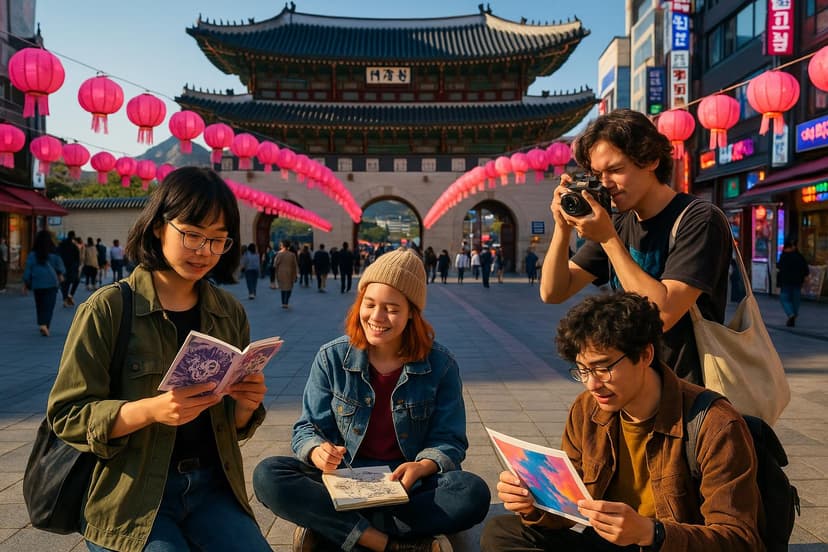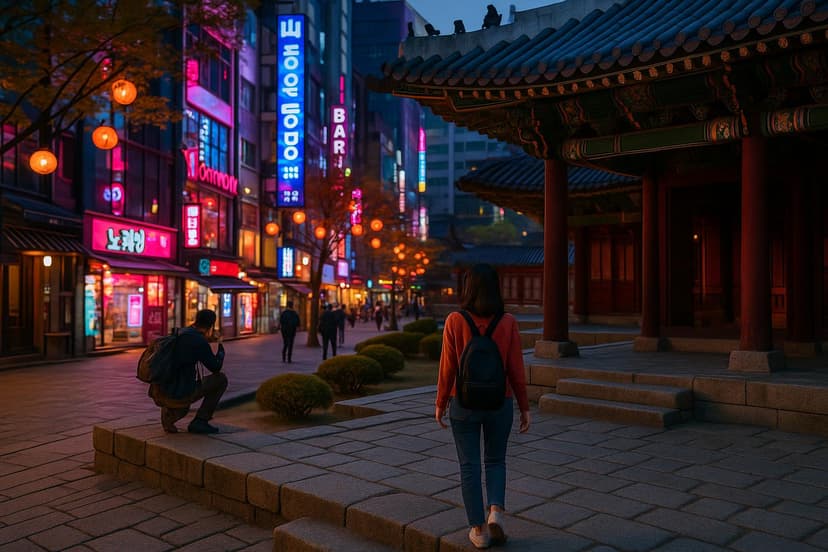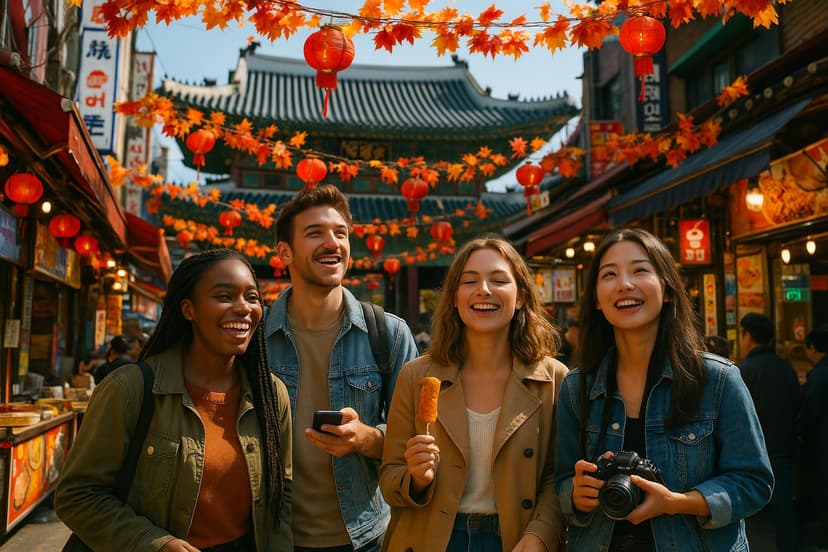Neon Nights & Hanok Dawns — 4-Day Photographic Chase in Seoul

A cinematic, alert, urban 4-day itinerary for photographers who want neon-soaked nights and quiet hanok dawns in November. Balances iconic viewpoints and local gems, with golden/blue-hour timing, permit notes, and flexible windows for spontaneous shots.
Highlights
- Blue-hour architecture at Dongdaemun Design Plaza (DDP)
- Dawn light across tiled roofs in Bukchon Hanok Village
- Sunrise panoramas at Haneul Park & Eungbongsan
- Night panoramas from N Seoul Tower and Banpo Bridge
- Gritty neon alleys: Ikseon-dong, Hongdae, Seongsu-dong
Itinerary
Day 1
Arrival, gear check, and first night chasing neon: DDP blue hour, street food energy at Gwangjang Market, and atmospheric hanok alleys in Ikseon-dong.
Afternoon: Central arrival, gear check and light rest
Settle into base in central Seoul, unpack camera gear, charge batteries, test lenses and plan blue hour route. Short nap or warm-up coffee — be ready for evening shoots.
Tips from local experts:
- If you stay in Myeong-dong, request a high-floor room for an emergency skyline scout; elevators and luggage trolleys are common there.
- Charge multiple batteries now—cold November nights reduce battery life by ~20%; keep spares in an inside pocket to stay warm.
- Map the nearest 24-hour convenience store (CU/GS25) and a Lokker to dry-warm lenses after shoot; many alleys have vending lockers near subway exits.
Blue hour & evening: Dongdaemun Design Plaza (DDP) — architecture and neon
Photograph the flowing metallic forms and illuminated led-curves as the city shifts from golden light to neon. Rooftop and exterior plazas give reflective angles for long exposures.
Tips from local experts:
- Arrive 30–45 minutes before sunset to scout the best exterior angles — the western plaza faces toward sunrise/sunset shift so blue hour colors last longer.
- Tripods are generally OK on the exterior plazas; interiors and exhibitions may restrict them—check signage. For commercial shoots you must apply to DDP management.
- For unique perspectives, use the pedestrian overpass near Dongdaemun History & Culture Park Station (Exit 1) to capture reflections and leading lines.
Street-food dinner and low-light candid scenes: Gwangjang Market
Capture hands-on night market portraits, sizzling pans, and neon stall signs. Gwangjang’s fabric alleys and food stalls have warm tungsten lighting ideal for mixed-light work.
Tips from local experts:
- Best to photograph food prep from the periphery; ask vendors before close portraits. Many vendors are used to photographers but consent is courteous and yields better shots.
- Bring a fast prime (50mm f/1.8) for low light and natural portraits; ISO 1600–3200 is common in November evenings.
- Use the second-floor seating to get slight elevation over the busy stalls for atmospheric environmental portraits and bokeh-rich scenes.
Ikseon-dong Hanok Village — neon-lit alleys & intimate hanok frames
After the market, stroll Ikseon-dong’s narrow lanes where hanok architecture is lit by café lights and neon signs — perfect for moody close-quarters night scenes.
Tips from local experts:
- Night shots here are intimate — use a wide aperture to isolate details (lamp-lit windows, wooden lattice). Respect diners and avoid blocking doorways.
- Tripods can be awkward in tight alleys; bring a small travel tripod or use a beanbag on ledges for stability.
- If a scene looks busy, step up to second-floor café windows (many allow shots if you buy a drink) for framed street-level compositions.
Late-evening: Cheonggyecheon Stream — reflections and urban lines
Walk the illuminated stream corridors for long-exposure reflections of neon and traffic. A calm place to close the night with glassy water surfaces and repeating bridges.
Tips from local experts:
- Blue-hour to late-night yields the calmest water — use neutral density if you want ultra-smooth surfaces and 5–10s exposures.
- Some bridges provide clean leading lines; avoid obstructed spots and check the nearest subway exit for an easy getaway.
- If you want people in frame, shoot slightly earlier when there’s still pedestrian traffic for environmental context, or later for empty minimalist frames.
Day 2
Hanok dawns and palace geometry: a dawn at Bukchon for tiled-roof silhouettes, palace ceremony rhythms at Gyeongbokgung, and quieter alleys and teahouses in Samcheong-dong and Seochon.
Pre-dawn transit & gear prep
Leave early to reach Bukchon before sunrise; dress warmly and ready batteries and ND/grad filters for high-contrast dawn scenes.
Tips from local experts:
- In November expect 0–10°C mornings—bring fingerless gloves for operating dials while keeping warmth.
- Use taxi or subway (Anguk Station) to save time; many alleys are steep and walking with heavy rigs is tiring.
- Scout a few rooftop viewpoints the evening before (some cafés open early) to save time at dawn.
Sunrise & golden hour: Bukchon Hanok Village — tiled rooflines and morning lattices
Chase soft, low-angle light across hanok roofs and chimneys. Aim for rooftop viewpoints for layered compositions; empty alleys in dawn offer unobstructed frames.
Tips from local experts:
- Respect residents—stay on public walkways and avoid using lights to illuminate private doorways. Commercial shoots require Jongno-gu permits; small editorial uses are typically tolerated but ask first.
- Golden-hour backlit eaves create rim-light—expose for highlights and recover midtones in RAW. Bracket exposures for HDR if you want full dynamic range of roofs and sky.
- For alternate quieter viewpoints, walk toward the Bukchon Observatory (on the east side) for elevated panoramas with fewer tourists in November mornings.
Hanok café breakfast: ONION Anguk (hanok branch)
Warm up in a hanok café that mixes traditional architecture with modern light — great for interiors, window portraits and hand-held low-light work.
Tips from local experts:
- ONION Anguk's hanok layout gives natural frame-within-frame compositions; ask for a window seat for morning light portraits.
- Small interiors are busy—if shooting interiors, request permission and visit early to avoid crowds.
- Use a fast lens for shallow depth-of-field food and detail shots (f/2–f/2.8 range) to isolate textures against wooden beams.
Mid-morning: Gyeongbokgung Palace — guards, gates, and geometry
Photograph palace courtyards, changing of the royal guard (check schedule), and the palace framed with Bukhansan in the distance. Use symmetrical compositions and people for scale.
Tips from local experts:
- Gyeongbokgung has an admission fee (usually modest). Tripods can be allowed in outdoor courtyards but are often restricted inside specific halls; check at the entrance desk.
- The royal guard ceremony (if running) happens in the morning—arrive early to secure foreground positions and shoot with a longer lens for candid detail.
- For less-crowded palace shots, head to the east side near the Gwanghwamun Gate at opening time or late afternoon before closing.
Lunch: Tosokchon Samgyetang — traditional light-filled interior portraits
A hearty ginseng chicken lunch in a hanok-style restaurant popular with locals for white-balance practice and environmental food photography.
Tips from local experts:
- This restaurant can be busy—arrive around 11:30 to avoid the lunch rush and secure framed interior shots.
- Warm tones from wooden interiors pair well with natural window light—use reflectors or bounce cards for even food lighting.
- If you need to photograph the whole interior, ask staff politely; many are accustomed to photographers but commercial shoots need prior permission.
Afternoon: Samcheong-dong & galleries — alleys, cafés, and detail studies
Wander Samcheong's quieter gallery streets for texture, window reflections, and modern-anachronistic compositions between art shops and hanok cafés.
Tips from local experts:
- Samcheong-dong has many small gallery spaces—check opening hours (some close early in November); plan interiors around natural light times.
- Use a 35mm or 24mm to capture alleys and storefront juxtapositions; try low-angle frames for painted walls and doorways.
- If a commercial interior shoot is planned, local galleries often require prior email permission; many are open to photography for editorial use if asked.
Late afternoon: Seochon Village — local life and hanok side-streets
Explore Seochon’s quieter lanes for intimate portraits of daily life, shopfronts and textured walls — a great counterpoint to the morning’s viewpoints.
Tips from local experts:
- Seochon is quieter in November; use portraits of shopkeepers and window displays to capture authentic local character.
- Battery and memory rundown after a long morning — swap memory cards and backup key files now to avoid data loss.
- For editorial shots of doorways and small businesses, a small wide-angle + fill flash gives controlled results without being intrusive.
Evening: Golden-hour approaches at Gwanghwamun Square — civic lines & illuminated statues
Return toward Gwanghwamun to catch late golden-hour tones on the statue and symmetrical civic lines — a calm nighttime warm-up before dinner.
Tips from local experts:
- Low sun in November creates long shadows on the plaza—use them for strong geometric compositions.
- The wide open plaza is tripod-friendly; bring a mid-length lens (24–70) for both detail and environmental civic portraits.
- If you want night reflections, the fountain areas near the square work well after sunset when lights come on.
Day 3
Parks and panoramas: early Haneul Park sunrise over the city, hip neighborhoods for editorial street work, Banpo and Namsan for river and skyline neon.
Pre-dawn transfer to Haneul Park (World Cup Park)
Head early to Haneul Park for elevated sunrise vistas over the Han River; November pampas grass may be waning but the skyline clarity is excellent.
Tips from local experts:
- Haneul Park is elevated with long stairs; bring light travel tripods and packable boots. There is a shuttle for limited mobility from the base.
- Weather tends to be crisp and clear in November mornings—carry lens cloths for condensation and a wind-blocking shell.
- Use a telephoto (70–200) for compressed skyline layers and a wide-angle (16–35) for panoramic foreground sweeping shots.
Sunrise & golden hour: Haneul Park — elevated Han River panoramas
Capture expansive skyline sweeps with leading grass textures; blue skies in November are crisp, producing high contrast scenes ideal for clarity in prints.
Tips from local experts:
- Aim for 30–45 minutes before and after sunrise for the best changing light; bracket exposures to handle dynamic range between sky and shadowed grass.
- There are several terraces—scout the west-facing platforms for city-line compression and the eastern slopes for layered foregrounds.
- Permits are not required for handheld or small-tripod personal shoots; for larger equipment or commercial shoots, contact Seoul's park office in advance.
Late morning: Mangwon Market and Mangwon-dong cafés — candid market life
Head to Mangwon Market for local food stalls, produce textures, and candid market portraits. Mangwon-dong cafés nearby offer hip interior frames and industrial light.
Tips from local experts:
- Markets are great for environmental portraits—use a 35mm to 50mm for natural perspective; ask subjects before shooting close-ups.
- Mangwon Market has narrow aisles—consider a small prime and fast aperture for indoor stalls in November light.
- Many cafés in Mangwon are daytime-only; check opening hours and request table near windows for café interior shoots.
Midday: Hongdae street session — performers, murals and candid youth culture
Capture dynamic street performance scenes, murals, and skateboard culture. Midday light works for colorful street portraits and environmentals.
Tips from local experts:
- Hongdae is busiest on weekends—weekdays yield more editorial control; scout small side alleys for cleaner backgrounds.
- Use a 24–70 for walk-and-shoot versatility; a 50mm prime is ideal for low-light café portraits later in the day.
- Be mindful of performers—ask permission for staged portraits and tip generously when appropriate; many accept being photographed for a small fee.
Afternoon: Seongsu-dong — industrial-chic, coffee shops and container architecture at Common Ground
Seongsu’s workshops and converted factories offer textured backdrops for editorial shoots; Common Ground’s shipping-container geometry is perfect for graphic compositions.
Tips from local experts:
- Common Ground is busy around late afternoon—use mezzanine vantage points for symmetrical container frames.
- Seongsu has many workshop facades; ask owners before photographing inside workspaces if you want close-ups of artisans.
- Bring polarizer for glare control on metal surfaces and sunglasses for comfortable long scouting sessions during bright November afternoons.
Golden hour & early night: Banpo Bridge at Hangang — river reflections and bridge lights
Capture smooth river reflections and the changing light as the bridge lighting shifts on; long exposures produce silk-like reflections against the lit arc of Banpo Bridge.
Tips from local experts:
- The Moonlight Rainbow Fountain schedule varies by season; in November full shows may be reduced—focus on bridge illumination and river reflections instead.
- Set tripod on the riverbank or small piers for stable long exposures; beware wet surfaces and pack a waterproof mat for gear.
- Use graduated ND or bracketed exposures to balance bright bridge lights and darker riverbanks in late autumn light.
Night panorama: N Seoul Tower (Namsan) — skyline and city lights
Finish the night with panoramic views from N Seoul Tower. The tower’s observation decks provide unobstructed city-light compositions and romantic cityscapes.
Tips from local experts:
- Observation deck access usually has a fee; tripods are often restricted—use a monopod or find ledges for support and carry a fast lens for low light.
- Cable car lines close earlier in winter—check the last times or take the Namsan shuttle/taxi for timed arrival to catch blue-hour transition.
- For quieter vantage points, hike slightly north along Namsan trails to reach less crowded terraces with unobstructed skyline frames.
Day 4
Final chase of alternative viewpoints and gritty texture: Eungbongsan sunrise panorama, Ihwa Mural alleys, Dongmyo flea-market grit, then a closing riverside blue-hour session in Yeouido.
Pre-dawn transfer to Eungbongsan Mountain (Eungbong) viewpoint
Quick transit to Eungbong for an east-facing sunrise over a compressed skyline and river — a favorite local sunrise spot with fewer tourists.
Tips from local experts:
- Eungbong uphill paths are short but steep—bring minimal kit and a headlamp for the pre-dawn walk in November.
- This viewpoint offers great compression with telephoto lenses (100–300mm) to line up towers; bring lens hood for low sun glare.
- Public transport access is limited pre-dawn—book a short taxi for time efficiency.
Sunrise & golden hour: Eungbongsan viewpoint — compressed Han River city skyline
Capture the city compressed across the Han River with soft morning light—excellent for telephoto skyline slices and layered compositions.
Tips from local experts:
- Arrive 20–30 mins before sunrise to set up and test exposures; November clarity yields strong contrast—dial back highlights to keep sky texture.
- Use 2–3 focal lengths: a wide for context, mid-tele for skyline slices, and long-tele for architectural details and patterns.
- The site is compact; respect other photographers and share framing positions — local shooters appreciate cordial swaps.
Morning: Ihwa Mural Village — murals, stairs and subtle street color
Explore Ihwa’s painted staircases and mural-filled alleys while they’re relatively empty—ideal for clean compositions of color and texture.
Tips from local experts:
- Ihwa can be crowded later; mornings in November are ideal for uninterrupted mural shots—avoid blocking stairs and paths.
- Many murals are on private walls—avoid shooting families in doorways without permission and give space to residents.
- Bring a small reflector to lift faces if you’re shooting portraiture; the alleys have mixed light that benefits from controlled fill.
Late morning: Dongmyo Flea Market — gritty textures and flea-market storytelling
Seek out unique props, vintage signage, and candid vendor portraits—perfect for documentary-style editorial photography.
Tips from local experts:
- Flea markets are full of small vendors—ask before photographing individuals and consider trading a printed photo or small token.
- Bring a macro or short telephoto for detail shots of textures (woven fabrics, metal patinas) and a 35mm for environmental context.
- Markets can be chaotic—keep gear close and insured; November crowds are thinner but still busy on weekends.
Lunch: Myeongdong Kyoja — comforting noodles and candid interior compositions
An iconic spot for quick, warm food and capturing the contrast between old recipes and modern diners.
Tips from local experts:
- This restaurant is famous and busy—try to arrive off-peak for cleaner interior frames and faster service.
- Use a 35mm for indoor environmental food shots and a slightly higher ISO to preserve shutter speed for hand-held images.
- If you want staff interaction shots, ask politely and consider a small tip in exchange for closer portraits.
Afternoon transfer to Yeouido Hangang Park and blue-hour prep
Head to Yeouido for a final riverside blue-hour session; find a place on the embankment to capture sunset city reflections and commuter lights.
Tips from local experts:
- Yeouido is windy in November—bring lens cloths and a sturdy tripod with low center of gravity for long exposures.
- Plan your vantage based on wind direction to minimize spray on lenses; a small shelter or windbreak can help for long shoots.
- Check ferry light schedules and tower-to-bridge alignments before setting up to maximize skyline reflection shots.
Blue hour & sunset: Yeouido Hangang Park — riverside city reflections
Capture the final cinematic frames: glass towers reflecting river light, commuter lines, and the city’s neon awakening from the riverbank.
Tips from local experts:
- Blue hour is short in November — be set up 20 minutes before sunset to catch the full tonal transition from gold to deep blue.
- Use mirror-lockup/2s timer and a remote release for tack-sharp long exposures of lights reflecting on the Han River.
- For alternative angles, take the small piers slightly downriver for fewer foreground distractions; local photographers often cluster at the main lawns—walk a few minutes for unique views.
Farewell evening: Casual wrap-up at Yeouido IFC / riverside dining
Close with a relaxed meal and image review near Yeouido’s IFC Mall or riverside cafés—backup files, swap contact info, and plan last prints.
Tips from local experts:
- Do a quick backup of critical files before your dinner; many cafés have limited outlets—carry a portable SSD/charger.
- If organizing a small print review, some cafés in IFC allow laptop setups; ask staff for a quiet corner.
- Finish with a light comparison shot of early vs late frames to see how November light impacted mood across the trip.







